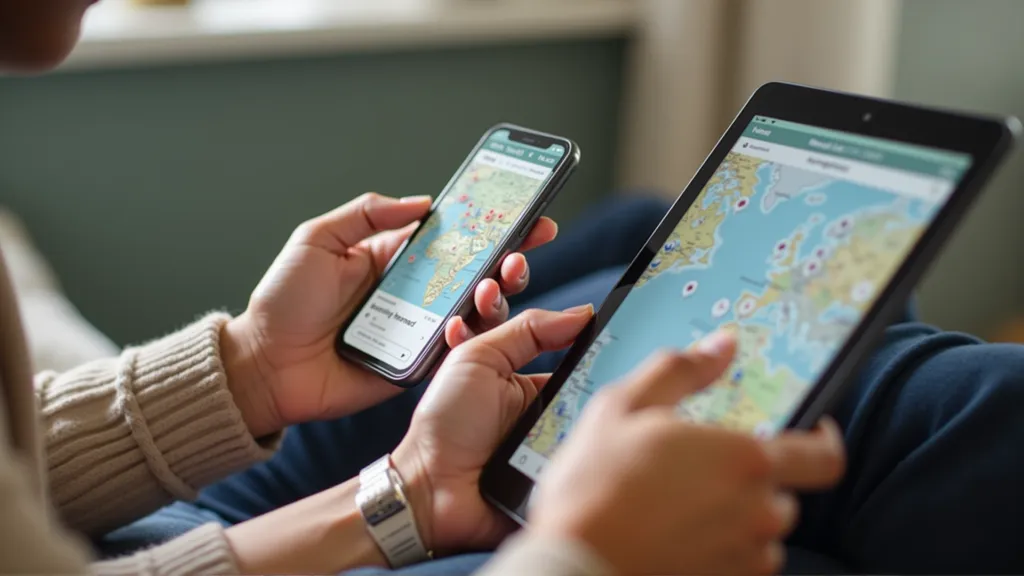The digital nomad lifestyle is full of promise—freedom, flexibility, and the thrill of discovering new cultures. Whether you’re working beachside in Bali or nestled in a cozy Lisbon café, the world is your office. But with so many incredible options, one big question remains: How to choose digital nomad destination for you?
It’s more than picking a place with fast Wi-Fi and good weather. To thrive on the road, you need a location that aligns with your values, lifestyle, and work needs.
That’s where this step-by-step guide comes in. You’ll learn how to research, compare, and rank potential destinations—so you can confidently pick your next home base with clarity, not guesswork.
For broader digital nomad tips to simplify life on the road, explore our Digital Nomad Tips to Simplify Life on the Road Today guide.
Define Your Digital Nomad Priorities & Non-Negotiables

Understanding Your Personal & Professional Needs
Before diving into Google searches or blog lists, take a pause. Choosing the right destination starts with knowing yourself.
Ask:
- What helps me feel safe, productive, and fulfilled?
- What do I absolutely need to live and work well?
Budget & Cost of Living Tolerance
First, be honest about your financial comfort zone. How much can you realistically spend each month?
Consider:
- Housing: Are you okay with shared apartments or do you need private space?
- Food & Dining: Do you eat out often or cook at home?
- Transportation: Will you walk, rent scooters, or need public transit?
- Activities: Think about costs for hobbies, fitness, or weekend getaways.
Work Style & Connectivity Requirements
Your work setup matters—a lot.
- Do you need ultra-fast internet for video calls or transferring large files?
- Are you more productive in coworking spaces, lively cafés, or quiet apartments?
- Will time zones affect your collaboration with teams or clients?
Social & Community Desires
Are you seeking community—or solitude?
- Do you thrive in places with a strong digital nomad network?
- Or do you want deeper cultural immersion with locals?
Some cities (like Medellín or Chiang Mai) are famous for their social scenes, while others offer a more relaxed, low-key vibe. Be clear on what energizes you.
Lifestyle & Activity Preferences
Where you live shapes how you live.
- Prefer beaches or mountains? Urban buzz or rural calm?
- What hobbies light you up—surfing, hiking, yoga, live music?
Choose a place that supports your favorite activities. This isn’t just about leisure—it’s about creating a balanced, joyful life.
Safety, Security & Quality of Life
Comfort is key.
- What’s your threshold for safety?
- Do you need access to quality healthcare, clean air, and safe tap water?
Research crime rates, healthcare infrastructure, and pollution indexes. These factors often go overlooked—but they deeply affect your well-being.
Career Goals & Networking Opportunities
Think long-term, too.
- Are you in a field where networking or industry hubs matter?
- Do you want to attend tech meetups, creative workshops, or entrepreneur events?
Places like Berlin, Lisbon, and Buenos Aires often host professional gatherings that can accelerate your career—and grow your social circle.
How to Choose Digital Nomad Destinations by Researching Key Data Points

Once you’ve defined what you need in a digital nomad destination, it’s time to start your research. This step is all about gathering the right information to evaluate your top choices.
Let’s break it down into practical, easy-to-compare categories. You don’t need to be a data analyst to do this—you just need to know what to look for.
Visa & Legal Frameworks
Before booking a flight, make sure you’re allowed to stay—and work—legally.
- Digital Nomad Visas: Does the country offer a visa specifically for remote workers? If so, check:
- Eligibility criteria (income requirements, insurance, background checks).
- Validity period (some offer 6 months, others 2 years).
- Cost and renewal process.
- Tourist Visas: These are often easier to get but may have limits on duration and work legality.
- Tax Implications: Some digital nomad visas require tax residency. Research whether you’ll owe income tax locally or if there are tax treaties with your home country.
💡 Example: Portugal offers a digital nomad visa with a one-year term and potential tax benefits under the NHR (Non-Habitual Resident) regime.
Deep Dive into Cost of Living
Knowing your budget is one thing—matching it to real-world costs is another.
Look into:
- Rent: Compare monthly costs for apartments, guesthouses, and co-living spaces.
- Food: How much does it cost to cook at home vs. eating out?
- Transport: Are buses, metro, or scooters common? How much do they cost?
- Healthcare: Will you need private insurance? What’s the cost of a doctor’s visit?
Sites like Numbeo, Expatistan, and local Facebook groups can give you reliable, up-to-date info.
Connectivity & Tech Infrastructure Assessment
You can’t work without good tech support.
- Internet Speed & Reliability: Look for real-user data on average speeds and downtime.
- Coworking Spaces: Are they common? Affordable? Well-reviewed?
- Power Stability: How frequent are blackouts? Are power banks or surge protectors a must?
💡 Example: Cities like Tallinn or Seoul have some of the fastest internet in the world, ideal for video-heavy work.
Safety, Healthcare, and Quality of Life Metrics
Peace of mind matters when you’re living abroad.
- Safety: Research crime rates, political stability, and areas to avoid.
- Healthcare: Are medical facilities modern and English-speaking? What’s the emergency care like?
- Environment: Clean air, walkable streets, and green spaces can boost your mental and physical health.
Cultural Immersion & Community Vibe
Living somewhere is more than ticking boxes—it’s about feeling at home.
- Local Culture: Is it easy to connect with locals? Are cultural norms welcoming?
- Digital Nomad Community: Are there meetups, coworking hubs, or expat events?
- Language Barriers: How widely is English spoken? Do locals appreciate you learning their language?
💡 Example: Mexico City has an active remote work scene, friendly locals, and a growing English-speaking expat community.
Activities, Environment & Mobility
Work-life balance is a big reason to go nomadic. Choose a place that helps you recharge.
- Leisure Activities: Beaches, mountains, museums, nightlife—what excites you?
- Weather: Check seasonal patterns. Is it rainy for months? Scorching hot?
- Getting Around: Is it easy to explore by foot, bike, or metro?
- Airport Access: Are you well-connected to other countries and continents?
Economic Landscape & Networking
Even if you’re fully remote, your surroundings can inspire growth.
- Startup Scene: Is the city buzzing with entrepreneurs and creatives?
- Networking Events: Look for regular workshops, conferences, or local business groups.
- Industry Presence: Some destinations are known for tech, design, writing, or marketing—does that align with your field?
💡 Example: Bangkok and Berlin are known for thriving coworking ecosystems and strong startup cultures.
Leveraging Data Sources & Tools for Research

Now that you know what you’re looking for and which factors to analyze, where do you find trustworthy data? Let’s dive into the best sources to help you make confident decisions.
Aggregator Platforms & Ranking Sites
These tools compile and score destinations based on multiple data points—perfect for comparing places side by side.
- Nomad List: Offers crowd-sourced insights on costs, internet speed, safety, weather, and more. It’s a go-to for many nomads.
- Numbeo & Expatistan: Ideal for drilling into cost of living by city or country.
- Voronoi: Known for its Top 100 Digital Nomad Destinations of 2025, which uses weighted metrics like safety, community, and lifestyle.
Official Government & Embassy Websites
Always check the official sites for up-to-date visa and tax details:
- Visa requirements (tourist vs. digital nomad visas)
- Tax residency laws
- Health insurance mandates
These are your best bet for accuracy—especially as policies change frequently.
Digital Nomad Forums & Social Media Groups
No one knows a place like those who’ve just been there.
- Reddit communities (like r/digitalnomad)
- Facebook groups by city or region
- Slack channels and Discord servers for remote workers
You’ll get the inside scoop on challenges, wins, and current vibes.
Visual Research
Sometimes a photo really is worth a thousand words.
- Instagram and YouTube help you see daily life, scenery, and cultural events.
- Look up hashtags like
#digitalnomad[city]or “day in the life [city]” for real-world context.
Bonus: Voronoi’s “Most Instagrammed Cities” list can offer visual clues about photogenic (and often fun) destinations.
Travel Blogs & Destination Guides
For honest storytelling and practical tips:
- Solo traveler blogs, expat diaries, and remote work journals give you context.
- Look for recent posts that include personal challenges, visa runs, and local hacks.
Developing Your Ranking System & Shortlisting Destinations

With data in hand, it’s time to turn information into insights. Here’s how to make smart, personalized comparisons.
Creating a Weighted Scorecard
First, go back to your priorities from Step 1—budget, lifestyle, community, etc. Rank them by importance.
- Assign a weight (e.g., 1–5) to each factor.
- Score each destination based on your research (e.g., rent affordability, safety, fast internet).
- Multiply and tally for a total score per location.
💡 Inspired by Voronoi’s data-driven system and DNO’s “layered priorities” model.
The Power of a Pros & Cons List
Numbers don’t always tell the full story.
- Add a personal “gut check” list.
- Look for deal-breakers (like poor healthcare) or unique perks (like island scuba diving).
Analyzing Return Rates (If Data Available)
Return rates can reveal how many nomads loved a place enough to go back.
- For example, Lisbon’s 24% return rate (according to Voronoi) signals a strong pull.
If available, prioritize destinations with high satisfaction rates—it’s a great proxy for livability.
Creating Your Top 3–5 Shortlist
Narrow down to a handful of strong contenders.
- Focus on 3 to 5 destinations that best align with your needs.
- Plan exploratory visits or longer test stays before making a final move.
Next up: We’ll walk you through how to test-drive your shortlist and make your final decision with confidence.
The “Test Drive” – Experiencing Before Committing

You’ve done the research—now it’s time to feel it out in real life. A short-term stay can reveal details no data point ever will.
The Value of a Short-Term Stay
Before you commit long-term, plan a 1- to 2-week test visit to your top choice.
- Get a feel for the pace of life and day-to-day rhythms.
- Try working from local cafés or coworking spaces.
- Chat with locals and other nomads to test how easy it is to connect.
Sometimes, what looks perfect on paper doesn’t quite click in person—and that’s okay.
What to Observe During Your Visit
As you explore, keep these key factors in mind:
- Internet reliability at your accommodation and workspaces.
- Transportation ease—is it walkable, bike-friendly, or Uber-reliant?
- The actual cost of food, coffee, transport, and daily essentials.
- The energy of the local scene. Is the digital nomad community active and welcoming?
A few days can offer more clarity than weeks of scrolling through rankings.
Conclusion: How to Choose the Right Digital Nomad Destination with Confidence

Choosing where to live as a digital nomad isn’t about chasing the most popular city—it’s about finding a place that truly fits you.
By following this step-by-step method—defining priorities, researching deeply, using smart tools, and taking a test drive—you can make a choice that supports your lifestyle, career, and personal growth.
Remember: the “best” destination is the one that meets your needs, not someone else’s highlight reel.
So why wait? Start exploring, get inspired, and create a shortlist that aligns with your goals.
👉 Ready to simplify your entire digital nomad journey? Dive into our comprehensive guide on Digital Nomad Tips to Simplify Life on the Road Today.



